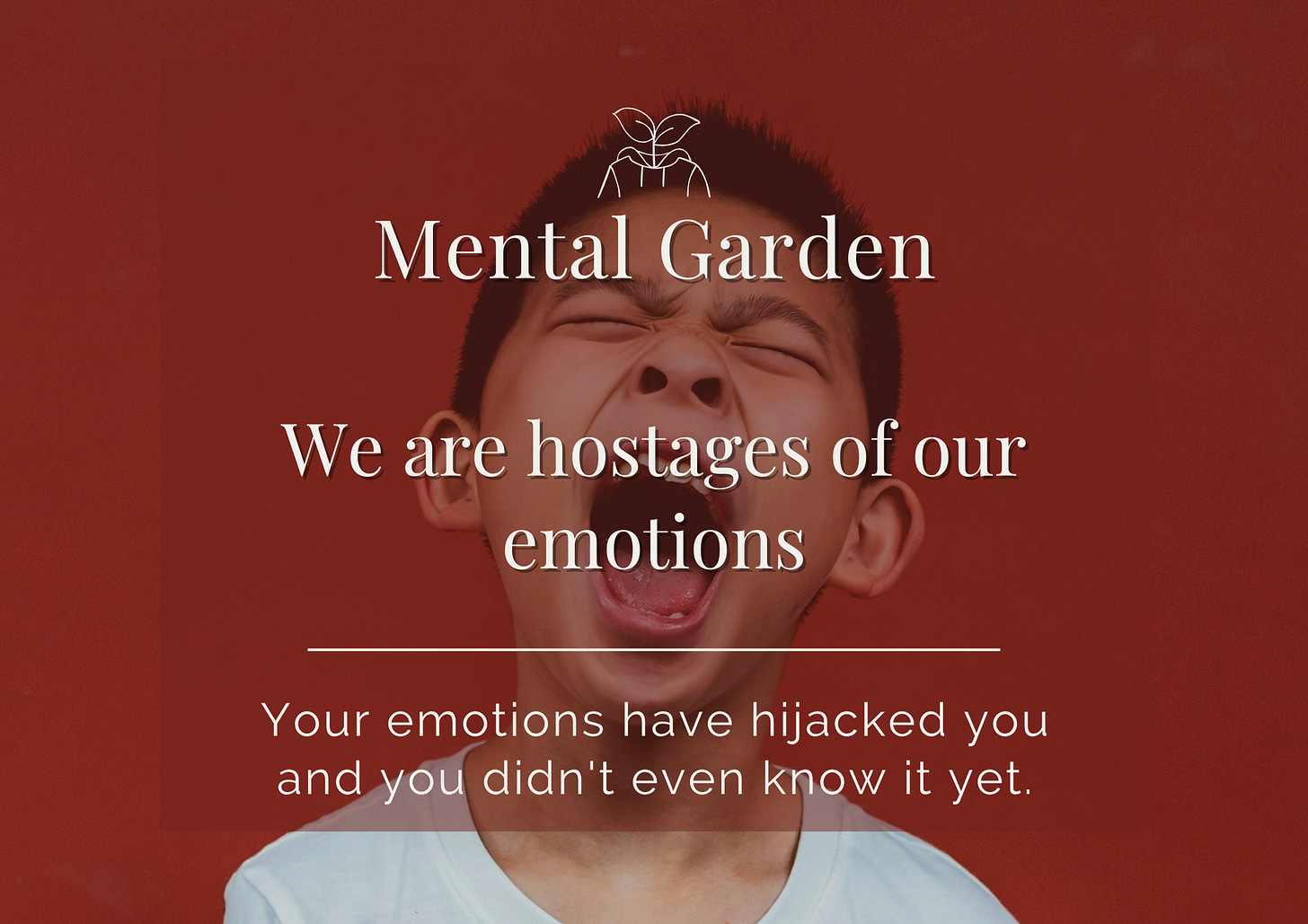We are hostages of our emotions
Your emotions have hijacked you and you didn't even know it yet.
🏷️ Categories: Behavior
Don't lie.
Have you ever looked back and thought, “Why did I do that stupid thing...?”
We think we are rational and know perfectly well why we do what we do. This is not so, in situations of sudden anger, fear or extreme emotion “emotional hijacking” occurs, your brain stops reasoning and you are guided by the feelings of the moment.
Have you ever gotten angry at someone on the road and honked at them? Have you responded poorly to a person on a stressful day? Your emotions hijacked you.
Amygdala vs. prefrontal cortex
The amygdala is the one who has kidnapped you and has a reason to do so.
The amygdala are 2 small formations (one in each hemisphere of the brain) that are in charge of processing emotions, especially those related to fear and anger. Their location means that first the information passes through here to then go to the prefrontal cortex, which is the area in charge of logical reasoning (Goleman, 2012).
This is interesting.
If you think about it, it makes evolutionary sense: first your brain creates feelings according to the information it perceives, then it starts to reason. Imagine you are out in nature and you hear a roar of an animal you don't see, what you would do is run away without thinking twice. Only after running for a while and seeing that nothing has happened is when you start to think about what animal it was.
In life and death situations you feel, you don't reason.
What happens in the brain
Amygdala and the prefrontal cortex have an inverse relationship (Kim et al., 2016).
We are calm, the prefrontal cortex is working on reasoning; emotions are triggered, blood and oxygen start going more intensely to the amygdala and you start to cloud up. It does not need to be a life or death situation, just a heated argument is enough for you to stop thinking clearly and let yourself be carried away by your feelings of the moment, be careful with that.
Psychologist Daniel Goleman points out that an emotional kidnapping has 3 parts:
Strong emotional reaction
Repeated action without awareness
Subsequent awareness of the action
Have you ever argued with someone, said something inappropriate and then apologized, spilled something on the table and punched the table, ever seen a tennis player break his racket after losing a match?
Well, that's it.
How to avoid being a hostage of your feelings
It's not easy to avoid emotional hijacking, but I know 3 techniques to achieve it.
Temporary distancing technique: This is my favorite and I use it every time I'm about to explode like a bomb 😅. When you feel this emotional pull, step away and think about how bad that problem will be in the next 5 days, 5 months and 5 years. You'll be surprised how many times you make a mountain out of a molehill.
Practice meditation: it has been shown that in as little as 8 weeks of meditation, people reduce the intensity of their emotional impulses (Kral et al., 2018). Spend a few minutes a day in meditation, find a quiet place, sit comfortably and focus on your breathing. I don't know if you will become a Buddha, but at least you will calm your impulsivity.
Expressive writing: This technique is powerful, spending 15 minutes writing about negative experiences or traumatic events improves our happiness and reduces stress (Baikie and Wilhelm, 2005). I know it works because I use it. I tell this story in full in my letter “Everything I learnt after journaling for a year.” When I come home upset about something I don't think twice; I go straight to my journal and release all that weight onto the pages. Words are my best psychologists.
✍️ Quote of the day: “If we admit that human life can be governed by reason, we destroy all possibility of life.” Leo Tolstoy, War and Peace
And you, do you often let yourself be carried away by your emotions or do you manage to restrain yourself?
See you next time! 👋
References 📚
Baikie, K. A., & Wilhelm, K. (2005). Emotional and physical health benefits of expressive writing. Advances In Psychiatric Treatment, 11(5), 338-346. https://doi.org/10.1192/apt.11.5.338
Cryan, J. F., & Dinan, T. G. (2012). Mind-altering microorganisms: the impact of the gut microbiota on brain and behaviour. Nature Reviews. Neuroscience, 13(10), 701-712. https://doi.org/10.1038/nrn3346
Goleman, D. (2012). Emotional intelligence: Why It Can Matter More Than IQ. Bantam.
Kim, M. J., Brown, A. C., Mattek, A. M., Chavez, S. J., Taylor, J. M., Palmer, A. L., Wu, Y., & Whalen, P. J. (2016). The Inverse Relationship between the Microstructural Variability of Amygdala-Prefrontal Pathways and Trait Anxiety Is Moderated by Sex. Frontiers In Systems Neuroscience, 10. https://doi.org/10.3389/fnsys.2016.00093
Kral, T. R., Schuyler, B. S., Mumford, J. A., Rosenkranz, M. A., Lutz, A., & Davidson, R. J. (2018). Impact of short- and long-term mindfulness meditation training on amygdala reactivity to emotional stimuli. NeuroImage, 181, 301-313. https://doi.org/10.1016/j.neuroimage.2018.07.013








